#greatest fear plots can be very good for revealing things about a character they don't outwardly show
Explore tagged Tumblr posts
Text

Despite everything I just said, this is really cute. I bet Amity believes her wholeheartedly, too.

Yup, that’s pretty much how I feel about spiders too.
And with that, I’ve reached the first ad break point, and I’m feeling a bit sleepy, so I’ll call it here for now! We’ll pick this up again very soon. This Grom fight is a trainwreck waiting to happen, and I’m both excited and extremely apprehensive about how it’s going to go!
#wingsy liveblogs#wingsy watches owl house#owls ep 16#greatest fear plots can be very good for revealing things about a character they don't outwardly show#but in this case I think it's more likely that it's going to force Luz herself to confront some issues she's been avoiding#or possibly both... which would certainly be interesting
18 notes
·
View notes
Text
Story Structures for your Next WIP
hello, hello. this post will be mostly for my notes. this is something I need in to be reminded of for my business, but it can also be very useful and beneficial for you guys as well.
everything in life has structure and storytelling is no different, so let’s dive right in :)
First off let’s just review what a story structure is :
a story is the backbone of the story, the skeleton if you will. It hold the entire story together.
the structure in which you choose your story will effectively determine how you create drama and depending on the structure you choose it should help you align your story and sequence it with the conflict, climax, and resolution.
1. Freytag's Pyramid
this first story structure i will be talking about was named after 19th century German novelist and playwright.
it is a five point structure that is based off classical Greek tragedies such as Sophocles, Aeschylus and Euripedes.
Freytag's Pyramid structure consists of:
Introduction: the status quo has been established and an inciting incident occurs.
Rise or rising action: the protagonist will search and try to achieve their goal, heightening the stakes,
Climax: the protagonist can no longer go back, the point of no return if you will.
Return or fall: after the climax of the story, tension builds and the story inevitably heads towards...
Catastrophe: the main character has reached their lowest point and their greatest fears have come into fruition.
this structure is used less and less nowadays in modern storytelling mainly due to readers lack of appetite for tragic narratives.
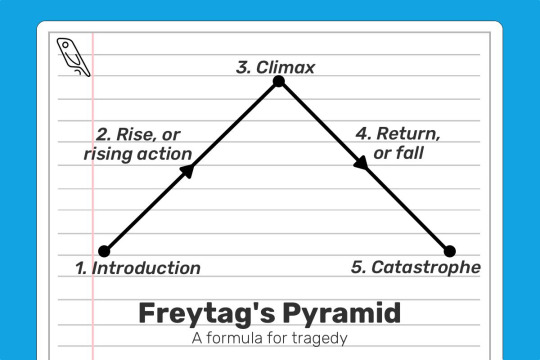
2. The Hero's Journey
the hero's journey is a very well known and popular form of storytelling.
it is very popular in modern stories such as Star Wars, and movies in the MCU.
although the hero's journey was inspired by Joseph Campbell's concept, a Disney executive Christopher Vogler has created a simplified version:
The Ordinary World: The hero's everyday routine and life is established.
The Call of Adventure: the inciting incident.
Refusal of the Call: the hero / protagonist is hesitant or reluctant to take on the challenges.
Meeting the Mentor: the hero meets someone who will help them and prepare them for the dangers ahead.
Crossing the First Threshold: first steps out of the comfort zone are taken.
Tests, Allie, Enemies: new challenges occur, and maybe new friends or enemies.
Approach to the Inmost Cave: hero approaches goal.
The Ordeal: the hero faces their biggest challenge.
Reward (Seizing the Sword): the hero manages to get ahold of what they were after.
The Road Back: they realize that their goal was not the final hurdle, but may have actually caused a bigger problem than before.
Resurrection: a final challenge, testing them on everything they've learned.
Return with the Elixir: after succeeding they return to their old life.
the hero's journey can be applied to any genre of fiction.

3. Three Act Structure:
this structure splits the story into the 'beginning, middle and end' but with in-depth components for each act.
Act 1: Setup:
exposition: the status quo or the ordinary life is established.
inciting incident: an event sets the whole story into motion.
plot point one: the main character decided to take on the challenge head on and she crosses the threshold and the story is now progressing forward.
Act 2: Confrontation:
rising action: the stakes are clearer and the hero has started to become familiar with the new world and begins to encounter enemies, allies and tests.
midpoint: an event that derails the protagonists mission.
plot point two: the hero is tested and fails, and begins to doubt themselves.
Act 3: Resolution:
pre-climax: the hero must chose between acting or failing.
climax: they fights against the antagonist or danger one last time, but will they succeed?
Denouement: loose ends are tied up and the reader discovers the consequences of the climax, and return to ordinary life.
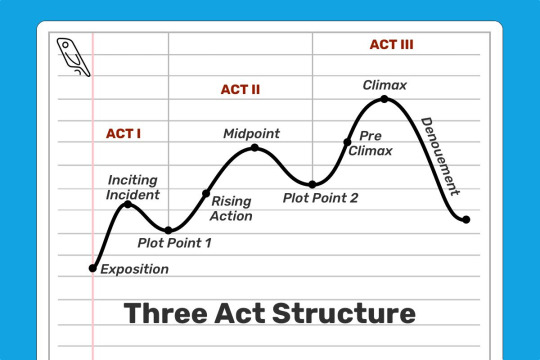
4. Dan Harmon's Story Circle
it surprised me to know the creator of Rick and Morty had their own variation of Campbell's hero's journey.
the benefit of Harmon's approach is that is focuses on the main character's arc.
it makes sense that he has such a successful structure, after all the show has multiple seasons, five or six seasons? i don't know not a fan of the show.
the character is in their comfort zone: also known as the status quo or ordinary life.
they want something: this is a longing and it can be brought forth by an inciting incident.
the character enters and unfamiliar situation: they must take action and do something new to pursue what they want.
adapt to it: of course there are challenges, there is struggle and begin to succeed.
they get what they want: often a false victory.
a heavy price is paid: a realization of what they wanted isn't what they needed.
back to the good old ways: they return to their familiar situation yet with a new truth.
having changed: was it for the better or worse?
i might actually make a operate post going more in depth about dan harmon's story circle.
5. Fichtean Curve:
the fichtean curve places the main character in a series of obstacles in order to achieve their goal.
this structure encourages writers to write a story packed with tension and mini-crises to keep the reader engaged.
The Rising Action
the story must start with an inciting indecent.
then a series of crisis arise.
there are often four crises.
2. The Climax:
3. Falling Action
this type of story telling structure goes very well with flash-back structured story as well as in theatre.
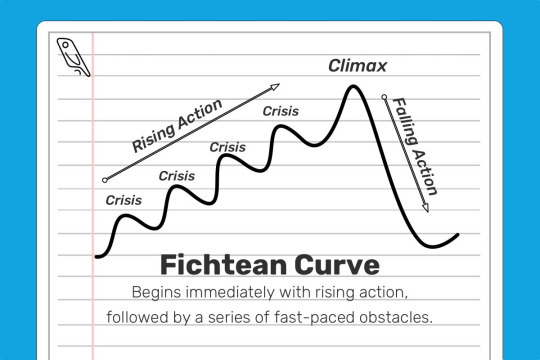
6. Save the Cat Beat Sheet:
this is another variation of a three act structure created by screenwriter Blake Snyder, and is praised widely by champion storytellers.
Structure for Save the Cat is as follows: (the numbers in the brackets are for the number of pages required, assuming you're writing a 110 page screenplay)
Opening Image [1]: The first shot of the film. If you’re starting a novel, this would be an opening paragraph or scene that sucks readers into the world of your story.
Set-up [1-10]. Establishing the ‘ordinary world’ of your protagonist. What does he want? What is he missing out on?
Theme Stated [5]. During the setup, hint at what your story is really about — the truth that your protagonist will discover by the end.
Catalyst [12]. The inciting incident!
Debate [12-25]. The hero refuses the call to adventure. He tries to avoid the conflict before they are forced into action.
Break into Two [25]. The protagonist makes an active choice and the journey begins in earnest.
B Story [30]. A subplot kicks in. Often romantic in nature, the protagonist’s subplot should serve to highlight the theme.
The Promise of the Premise [30-55]. Often called the ‘fun and games’ stage, this is usually a highly entertaining section where the writer delivers the goods. If you promised an exciting detective story, we’d see the detective in action. If you promised a goofy story of people falling in love, let’s go on some charmingly awkward dates.
Midpoint [55]. A plot twist occurs that ups the stakes and makes the hero’s goal harder to achieve — or makes them focus on a new, more important goal.
Bad Guys Close In [55-75]. The tension ratchets up. The hero’s obstacles become greater, his plan falls apart, and he is on the back foot.
All is Lost [75]. The hero hits rock bottom. He loses everything he’s gained so far, and things are looking bleak. The hero is overpowered by the villain; a mentor dies; our lovebirds have an argument and break up.
Dark Night of the Soul [75-85-ish]. Having just lost everything, the hero shambles around the city in a minor-key musical montage before discovering some “new information” that reveals exactly what he needs to do if he wants to take another crack at success. (This new information is often delivered through the B-Story)
Break into Three [85]. Armed with this new information, our protagonist decides to try once more!
Finale [85-110]. The hero confronts the antagonist or whatever the source of the primary conflict is. The truth that eluded him at the start of the story (established in step three and accentuated by the B Story) is now clear, allowing him to resolve their story.
Final Image [110]. A final moment or scene that crystallizes how the character has changed. It’s a reflection, in some way, of the opening image.
(all information regarding the save the cat beat sheet was copy and pasted directly from reedsy!)
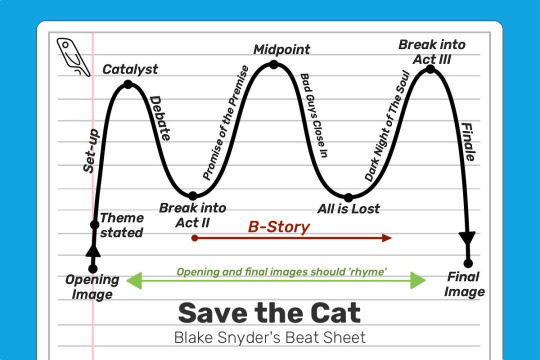
7. Seven Point Story Structure:
this structure encourages writers to start with the at the end, with the resolution, and work their way back to the starting point.
this structure is about dramatic changes from beginning to end
The Hook. Draw readers in by explaining the protagonist’s current situation. Their state of being at the beginning of the novel should be in direct contrast to what it will be at the end of the novel.
Plot Point 1. Whether it’s a person, an idea, an inciting incident, or something else — there should be a "Call to Adventure" of sorts that sets the narrative and character development in motion.
Pinch Point 1. Things can’t be all sunshine and roses for your protagonist. Something should go wrong here that applies pressure to the main character, forcing them to step up and solve the problem.
Midpoint. A “Turning Point” wherein the main character changes from a passive force to an active force in the story. Whatever the narrative’s main conflict is, the protagonist decides to start meeting it head-on.
Pinch Point 2. The second pinch point involves another blow to the protagonist — things go even more awry than they did during the first pinch point. This might involve the passing of a mentor, the failure of a plan, the reveal of a traitor, etc.
Plot Point 2. After the calamity of Pinch Point 2, the protagonist learns that they’ve actually had the key to solving the conflict the whole time.
Resolution. The story’s primary conflict is resolved — and the character goes through the final bit of development necessary to transform them from who they were at the start of the novel.
(all information regarding the seven point story structure was copy and pasted directly from reedsy!)
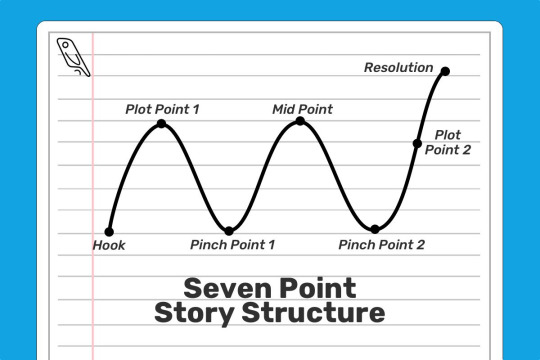
i decided to fit all of them in one post instead of making it a two part post.
i hope you all enjoy this post and feel free to comment or reblog which structure you use the most, or if you have your own you prefer to use! please share with me!
if you find this useful feel free to reblog on instagram and tag me at perpetualstories
Follow my tumblr and instagram for more writing and grammar tips and more!
#writing#writing advice#writing tips#original writing#writers on tumblr#writerscommunity#writersconnection#writersofig#writersofinstagram#writings
13K notes
·
View notes
Note
As the youngest child who has overprotective sisters and enjoys karate, I relate to Aelia so much. Is there anything you could reveal about her? What are her powers going to be (please make her super powerful I live for deadly fairy princesses)? What's she like? Does she have a lot of hobbies? What's her love life like (apart from Sayara ofc did I mention even though I don't know them I love her and Sayara)? What's her arc in the series going to be about? Thanks, and sorry for all the questions.
No need to apologize for questions! I am ALWAYS down to talk about Aelia Ravenhart, I too adore her. Unfortunately, I can’t get too deep into her destiny here, since it’s absolutely LOADED with spoilers. She’s a character who sort of embodies the world and plot in a meta sense--while she’s not canonically a cosmic keystone or anything heavy like that, I do deliberately use her to represent the state of the world in a lot of ways. The stuff that happens to her is directly related to the stuff that’s happening to Feilan, and her personal arc and trials are deliberate parallels to the way the world changes around her and the other leads. Her magic is a key example of this... I’ll throw you some crumbs, though, she does become super powerful. Her powers are also very unique in both nature and application, she has a notably rare skillset and she uses it mixed with her martial arts in a way that’s not seen anywhere else in the world of the story. She’s gotta go through hell to earn that magic, and she doesn’t have anything remarkable until book 4, but when she gets it she gets a lot of it.
Her personal arc is about coming to a place of comfort with herself, and her relationship to her family. It’s close to a classic coming-of-age storyline. She starts out as this very gung-ho rebellious kid, and has to grow into someone who can handle responsibility without losing herself! She also has to figure out how to deal with her sisters. Aelia’s the most mentally stable of the Ravenharts, but she’s constantly exhausted dealing with the twins. Violet is always angry, Lavender is so depressed that she doesn’t seem to have a personality sometimes, and Aelia has to live with this and keep it from weighing too hard on her. It’s a lot of trouble. Plus Violet has this really toxic mentality that there’s nothing she can do about her own problems, and so she needs to be “saved” from her angst by external forces (aka her sisters). “Take care of myself? Shower unprompted? Actually go to the therapists at the national hospital, which are the best in the world, who could help me cope with this? ahhaha what’s that neurotypical bullshit.” that kind of thing. This fucks with Elli’s head for obvious reasons. She just wants to be herself, you know? But it feels like she’s not allowed to, because the twins have things so much worse, and they won’t stop reminding her about it.
She hates being forced to sit down and deal with other people’s depression trauma in general--they’re all traumatized here, but since Aelia is (relatively) good at coping, nobody notices unless she bashes them in the face with it. She won’t do that, because she’s watched Violet do it enough to know it’s an awful thing to do to somebody. At first, she straight up tries to ignore the twins’ problems and talk reason to them. She doesn’t want to hear about it. Her character development pushes her towards accepting that no, she doesn’t have to fix her family, but she should at least show them a little pity. She has to move on from her obsession with how her family suffocates her, and strike a balance between tradition and transformation. It’s not a coincidence that she’s symbolically tied to lightning, my personal symbol of rebirth through destruction--that’s what Aelia needs to represent. She needs to find it in herself to destroy some of her own status quo, and she needs to find it in herself to let her relationship with her family and their traditions be reborn instead of just fading into the void.
Aelia serves as a vessel for the series theme as a whole. Feilan is about rejuvenation and rebirth, the story of a stagnant country in a stagnant world that’s too afraid of losing something to move forward and build something new--until the algae fills the pond and chokes it out and something must be done. Elli carries the shift. She’s frustrated with the traditions of her family, she’s frustrated with the traditions of her country, she’s frustrated in all those ways that teenagers are when we start to notice that we live in a broken world. She’s not sure what to do about it yet, but she’s ready to burn things down if that’s what it takes. Sayara drives the plot, Aelia embodies it.
I wouldn’t say she has that many hobbies, honestly, other than the ones I’ve mentioned in the WIP page. Which I guess isn’t on this blog, but on my writing one. She’s a princess in a country whose royals are expected to be politically active and occupied, so she spends most of her time learning how to move through social circles and deal with the day-to-day of being a VIP. She will probably never inherit, since she’s behind Violet and Lavender in the succession and Violet would rather die, but she’s still expected to marry into higher nobility eventually and be an executive leader type. When she’s not in tutoring lessons, she’s probably practicing martial arts or music. They help her calm down.
Romance-wise, she doesn’t have much of a love life before the series. She’s had crushes, but they haven’t gone anywhere... At the beginning of book 1 she’s only just turned 14, and it’s considered inappropriate to start pursuing romances before you’re 14 or 15, especially for nobility. She’s great at slick pickup lines but has had very few chances to use them, and if someone actually responded favorably she’d panic and not know what to do. That’d be super cute for an AU Tuesday thing where Sayara has working observation skills. She’s definitely had crushes on a couple classmates, but nothing that lasted--being a princess makes the power dynamics weird, and makes approaching her very intimidating for someone who’s not on her level. (Also, if anyone tried to date Aelia, Violet would kill them. This takes the intimidation up to 11.) Once she does meet Sayara, she gets a crush pretty quickly and stops paying attention to anyone else. Unfortunately for her, Sayara’s too heartblind to notice anything. I kid you not, there is a scene in book 3 where they dance together and call each other beautiful and almost kiss, and even THAT does not get Sayara’s attention as a potential romantic approach. She’s just like “oh Aelia my greatest friend” and Aelia dies on the inside. One of my greatest fears with these books is that I’ll be accused of queerbaiting somehow because Aelia’s constantly flirting and it doesn’t go anywhere, but Sayara’s just so goddamn oblivious and focused on everything else that it takes the entire massive spoiler drama of book 3 for her to figure out Elli liked her. She is an ex-self insert, after all.
I wanna add a side note re: that romance here, since it came up, just because it’s a hotbutton topic--I do have an out-of-story reason for Sayara being a dumbass, and it’s because I don���t want to drive in any problematic Angsty Gay tropes by having them get together too early. There are a few different situations in book 3 that would become some really bad tropes if the gals were a couple at that point--everyone in this series goes through a lot of awful stuff, Aelia especially, and I don’t want even the slightest implication that any of it might be happening because of a gay romance. That would be objectively worse than teasing. They’ll get together in book 4 and it’ll be glorious and dramatic and cute as hell, but until then, they can stay just friends and angst as just friends. This is also a fair warning for you... Aelia goes through A LOT. I promise you everyone gets a happy ending eventually, but before that can happen, there’s a significant amount of pain and hard work involved.
Absolutely feel free to ask more questions, though! I do love my fairies, and I need to develop Aelia better. She’s skirting the manic pixie dream girl line right now in a way that is the polar opposite of what I want out of her character.
#taz shut up#feilan#btw you should really send these to taz-writes#that's my writing blog after all :>#there's a lot more feilan stuff there#Anonymous
4 notes
·
View notes